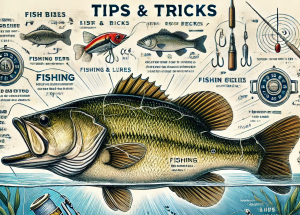Currently Empty: $0.00

Fishing for bass is a thrilling and rewarding experience for both novice and seasoned anglers. The thrill of the catch, the tranquility of nature, and the challenge of outsmarting a cunning fish make bass fishing a favorite pastime. To help you become a successful angler, here are tips and tricks to make a difference in your fishing for bass adventures. Each tip is designed to enhance your strategy, increase your catch rate, and make your time on the water more enjoyable.
1. Choose the Right Equipment
Selecting the appropriate fishing gear is the first step to successful bass fishing. Use a medium-heavy rod and reel combo with a good drag system. This setup provides the versatility needed to handle bass of various sizes. Additionally, opt for braided fishing line for bass, which offers superior strength and sensitivity, allowing you to feel even the slightest nibble.
2. Learn About Bass Behavior
Understanding bass behavior is crucial to where to catch bass. Bass are often found near structures like rocks, logs, and weed beds where they can ambush prey. They are also more active during low light conditions, such as early morning and late evening. Observing these patterns can help you determine the best times and places to fish.
3. Master the Art of Casting
Perfecting your casting technique is essential for accurate and effective fishing. Practice different types of casts, such as overhead, sidearm, and pitch casts, to improve your accuracy. Aim for quiet and precise casts to avoid spooking the fish. The ability to place your lure exactly where you want it can significantly increase your chances of a successful catch.
4. Use the Right Lures
The type of lure you use can greatly influence your success in bass fishing. Popular choices include plastic worms, crankbaits, and spinnerbaits. Match the lure to the water conditions and the natural prey of the bass. Experiment with different colors and sizes to see what works best on any given day.
5. Vary Your Retrieval Techniques
Bass can be finicky, so varying your retrieval techniques is key to triggering strikes. Try different speeds and patterns, such as a steady retrieve, a stop-and-go motion, or a twitching action. Observing how bass respond to different retrieves can help you determine the most effective technique for the day.
6. Pay Attention to Weather Conditions
Weather conditions have a significant impact on bass activity. Overcast days are often better for fishing as bass are more likely to be found in shallow waters. On sunny days, they tend to retreat to deeper, cooler areas. Keep an eye on the weather forecast and adjust your fishing strategy accordingly.
7. Be Patient and Persistent
Bass fishing requires a great deal of patience and persistence. There will be days when the fish are not biting, but don’t get discouraged. Keep experimenting with different techniques and locations until you find what works. Remember, persistence pays off in the long run.
8. Practice Catch and Release
Sustainable fishing practices are essential to preserving bass populations for future generations. Practice catch and release to help maintain healthy fish stocks. Handle the fish gently, minimize their time out of water, and use barbless hooks to reduce injury. Ensuring the survival of the bass you catch will contribute to a thriving ecosystem.
Analysis of Bass Fishing Techniques
To understand the effectiveness of different bass fishing techniques, let’s analyze their impact on catch rates and fish behavior. The chart below provides a comparative analysis of various techniques based on reported success rates.
| Technique | Average Catch Rate | Ideal Conditions | Notes |
|---|---|---|---|
| Plastic Worms | High | Weedy and rocky areas | Versatile and effective in various conditions |
| Crankbaits | Medium | Open water, near structures | Great for covering large areas |
| Spinnerbaits | High | Murky water, around cover | Attracts bass with flash and vibration |
| Topwater Lures | Medium | Early morning, late evening | Exciting visual strikes |
| Jigs | Medium | Deep water, around structures | Effective for large bass |
Conclusion
Bass fishing is both an art and a science, requiring knowledge, skill, and a bit of luck. By choosing the right equipment, understanding bass behavior, mastering casting techniques, using appropriate lures, varying retrieval methods, paying attention to weather conditions, being patient, and practicing catch and release, you can enhance your bass fishing experience. Remember, the key to successful bass fishing lies in continuous learning and adapting to changing conditions. Happy fishing!


